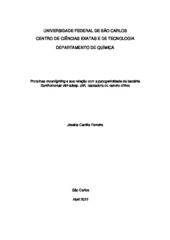| dc.contributor.author | Ferreira, Jéssica Camila | |
| dc.date.accessioned | 2022-05-03T10:54:31Z | |
| dc.date.available | 2022-05-03T10:54:31Z | |
| dc.date.issued | 2022-04-11 | |
| dc.identifier.citation | FERREIRA, Jéssica Camila. Proteínas moonlighting e sua relação com a patogenicidade da bactéria Xanthomonas citri subsp. citri, causadora do cancro cítrico. 2022. Trabalho de Conclusão de Curso (Graduação em Química) – Universidade Federal de São Carlos, São Carlos, 2022. Disponível em: https://repositorio.ufscar.br/handle/ufscar/15967. | * |
| dc.identifier.uri | https://repositorio.ufscar.br/handle/ufscar/15967 | |
| dc.description.abstract | Citriculture has been present in Brazil since its colonization when orange seedlings
were imported and commercialized. Due to the fertile soil and favorable climate,
over the decades, Brazil has become the largest producer of oranges and exporter
of orange juice worldwide, generating a lot of profit for the country. Nevertheless,
over time, several diseases that bring significant losses to the citrus industry have
also developed, and many of them still have no cure. Citrus canker is one of them
and is caused by the bacterium Xanthomonas citri subsp. citri (Xac). Many
investigations have been carried out to elucidate the infection mechanism of the
bacteria in the host, how they defend themselves and why they are so virulent. After
a proteomic analysis of the cell surface performed on Xac under two different
conditions, host infection and non-infection, different amounts of some proteins on
the surface were found, being many of them already reported and related to
virulence in other bacteria and classified as moonlighting proteins, which are
proteins that have a well-defined function usually in the cytosol, but were also found
performing completely different functions in other cellular regions, mostly on the
surface.
Such proteins may be related to biofilm production, defense response
against the host, adhesion of bacteria to surfaces, and various other functions.
Studies in recent years have tried to unravel their possible recognition mechanisms
inside the cell and how they are secreted out, as well as trying to understand what
functions they have when they are on the surface. In this work, the topics mentioned
above were addressed in detail and the possible relationship of surface
moonlighting proteins with the virulence of the citrus canker-causing bacteria was
discussed. | eng |
| dc.description.sponsorship | Não recebi financiamento | por |
| dc.language.iso | por | por |
| dc.publisher | Universidade Federal de São Carlos | por |
| dc.rights | Attribution-NonCommercial-NoDerivs 3.0 Brazil | * |
| dc.rights.uri | http://creativecommons.org/licenses/by-nc-nd/3.0/br/ | * |
| dc.subject | Proteínas moonlighting | por |
| dc.subject | Cancro cítrico | por |
| dc.subject | Moonlighting proteins | eng |
| dc.subject | Citrus canker | eng |
| dc.subject | Xanthomonas citri | eng |
| dc.title | Proteínas moonlighting e sua relação com a patogenicidade da bactéria Xanthomonas citri subsp. citri, causadora do cancro cítrico | por |
| dc.title.alternative | Moonlighting proteins and their relationship with bacterial pathogenicity Xanthomonas citri subsp. citri, which causes citrus canker | eng |
| dc.type | TCC | por |
| dc.contributor.advisor1 | Souza, Dulce Helena Ferreira de | |
| dc.contributor.advisor1Lattes | http://lattes.cnpq.br/3428955299526003 | por |
| dc.description.resumo | A citricultura está presente no Brasil desde sua colonização, quando mudas de
laranja foram trazidas e comercializadas. Devido ao solo fértil e clima favorável, ao
longo das décadas, o Brasil se tornou o maior produtor de laranjas e exportador de
suco de laranja do mundo, gerando muito lucro para o país. Porém, com o
passar do tempo também se desenvolveu diversas doenças que trazem grandes
prejuízos para a citricultura e muitas delas ainda não têm cura. O cancro cítrico é
uma delas e é causado pela bactéria Xanthomonas citri subsp. citri (Xac). Muitas
pesquisas têm sido realizadas a fim de elucidar o mecanismo de infecção da
bactéria no hospedeiro, como elas fazem para se defender e porque são tão
virulentas. Após uma análise proteômica da superfície celular realizada em Xac
em duas condições diferentes, de infecção no hospedeiro e não infecção, foram
constatadas diferentes quantidades de algumas proteínas na superfície, onde
muitas delas já haviam sido relatadas e relacionadas com a virulência em
outras bactérias e foram classificadas como proteínas moonlighting, que são
proteínas que possuem uma função bem definida, geralmente no citosol, mas que
também foram encontradas desempenhando funções completamente diferentes
em outras regiões celulares, na maioria das vezes na superfície. Tais proteínas
podem estar relacionadas com a produção de biofilme, resposta de defesa contra
o hospedeiro, adesão das bactérias nas superfícies e diversas outras funções.
Estudos realizados nos últimos anos tentaram desvendar seus possíveis
mecanismos de reconhecimento dentro da célula e como são secretadas para
fora, além de tentar entender quais funções elas possuem quando estão na
superfície. Neste trabalho, os tópicos citados acima foram abordados de forma
detalhada e discutiu-se a possível relação das proteínas moonlighting encontradas
superficialmente com a virulência da bactéria causadora do cancro cítrico. | por |
| dc.publisher.initials | UFSCar | por |
| dc.subject.cnpq | CIENCIAS BIOLOGICAS::BIOQUIMICA::QUIMICA DE MACROMOLECULAS::PROTEINAS | por |
| dc.publisher.address | Câmpus São Carlos | por |
| dc.publisher.course | Química - Q | por |

